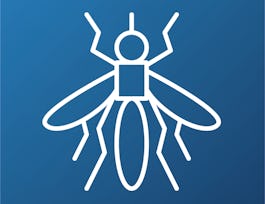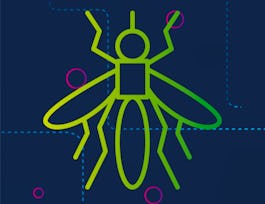The other two courses in this specialisation require you to perform deterministic modelling - in other words, the epidemic outcome is predictable as all parameters are fully known. However, this course delves into the many cases – especially in the early stages of an epidemic – where chance events can be influential in the future of an epidemic. So, you'll be introduced to some examples of such ‘stochasticity’, as well as simple approaches to modelling these epidemics using R. You will examine how to model infections for which such ‘population structure’ plays an important role in the transmission dynamics, and will learn some of the basic approaches to modelling vector-borne diseases, including the Ross-McDonald Model.



Building on the SIR Model
This course is part of Infectious Disease Modelling Specialization

Instructor: Nimalan Arinaminpathy
Sponsored by Syrian Youth Assembly
3,024 already enrolled
(23 reviews)
What you'll learn
Distinguish between stochastic and deterministic models, explain when either are appropriate, and perform simple simulations of a stochastic model
Identify where it is important to incorporate population structure in a model and design and simulate a transmission model capturing such structure
Evaluate the assumptions behind the Ross MacDonald model, and code such a model using R to simulate the dynamics of a vector-borne disease
Critically evaluate a modelling study and communicate its strengths and weaknesses to a scientifically literate audience
Details to know

Add to your LinkedIn profile
See how employees at top companies are mastering in-demand skills

Build your subject-matter expertise
- Learn new concepts from industry experts
- Gain a foundational understanding of a subject or tool
- Develop job-relevant skills with hands-on projects
- Earn a shareable career certificate


Earn a career certificate
Add this credential to your LinkedIn profile, resume, or CV
Share it on social media and in your performance review

There are 4 modules in this course
The other two courses in this specialisation have focused on performing deterministic modelling - that is, the epidemic outcome is predictable as all parameters are fully known. However, there are many cases, especially in the early stages of an epidemic, where chance events can be influential in the future of an epidemic. In this module, you will be introduced to some examples of such ‘stochasticity’, as well as, simple approaches to modelling these epidemics using R.
What's included
5 videos8 readings3 discussion prompts5 ungraded labs
In the basic deterministic SIR model, all susceptible individuals in a population are subject to the same risks of infection. However, there are many important infectious diseases where certain groups of the population account for a disproportionate amount of transmission: these are not always the same groups that bear the greatest amount of morbidity and mortality. In this module, you will examine how to model infections for which such ‘population structure’ plays an important role in the transmission dynamics.
What's included
2 videos2 readings4 discussion prompts6 ungraded labs
Many important diseases are not directly transmitted between hosts, but depend on ‘vectors’ to pass infection between hosts, for example biting insects. It is important to be able to extend the modelling approaches you have studied so far to capture these more complex forms of natural history. In this module, you will learn some of the basic approaches to modelling vector-borne diseases, including the Ross-McDonald model, which is a framework that provides an important foundation for such diseases.
What's included
6 videos1 reading2 discussion prompts4 ungraded labs
Even if you are not designing and simulating mathematical models in future, it is important to be able to critically assess a model, to appreciate its strengths and weaknesses, and to identify how it could be improved. One way of gaining this skill is to conduct a critical peer review of a modelling study in the position of a reviewer evaluating it for publication in a journal. This module is reserved for the completion of your assignment - for you to apply the knowledge and skills you've developing throughout this specialisation.
What's included
1 peer review1 discussion prompt
Instructor

Offered by
Why people choose Coursera for their career




Learner reviews
23 reviews
- 5 stars
78.26%
- 4 stars
17.39%
- 3 stars
0%
- 2 stars
0%
- 1 star
4.34%
Showing 3 of 23
Reviewed on Jul 28, 2023
This course is really amazing .Excellent insight learning and gives room for nurturing the knowledge gained.
Reviewed on Jul 1, 2023
The peer review grade is not working properly. It is not showing result.
Reviewed on Jun 19, 2021
a great follow up to the R coding course and a good entree into the world of public health
Recommended if you're interested in Health

Imperial College London

Johns Hopkins University

Johns Hopkins University

Imperial College London

Open new doors with Coursera Plus
Unlimited access to 10,000+ world-class courses, hands-on projects, and job-ready certificate programs - all included in your subscription
Advance your career with an online degree
Earn a degree from world-class universities - 100% online
Join over 3,400 global companies that choose Coursera for Business
Upskill your employees to excel in the digital economy


